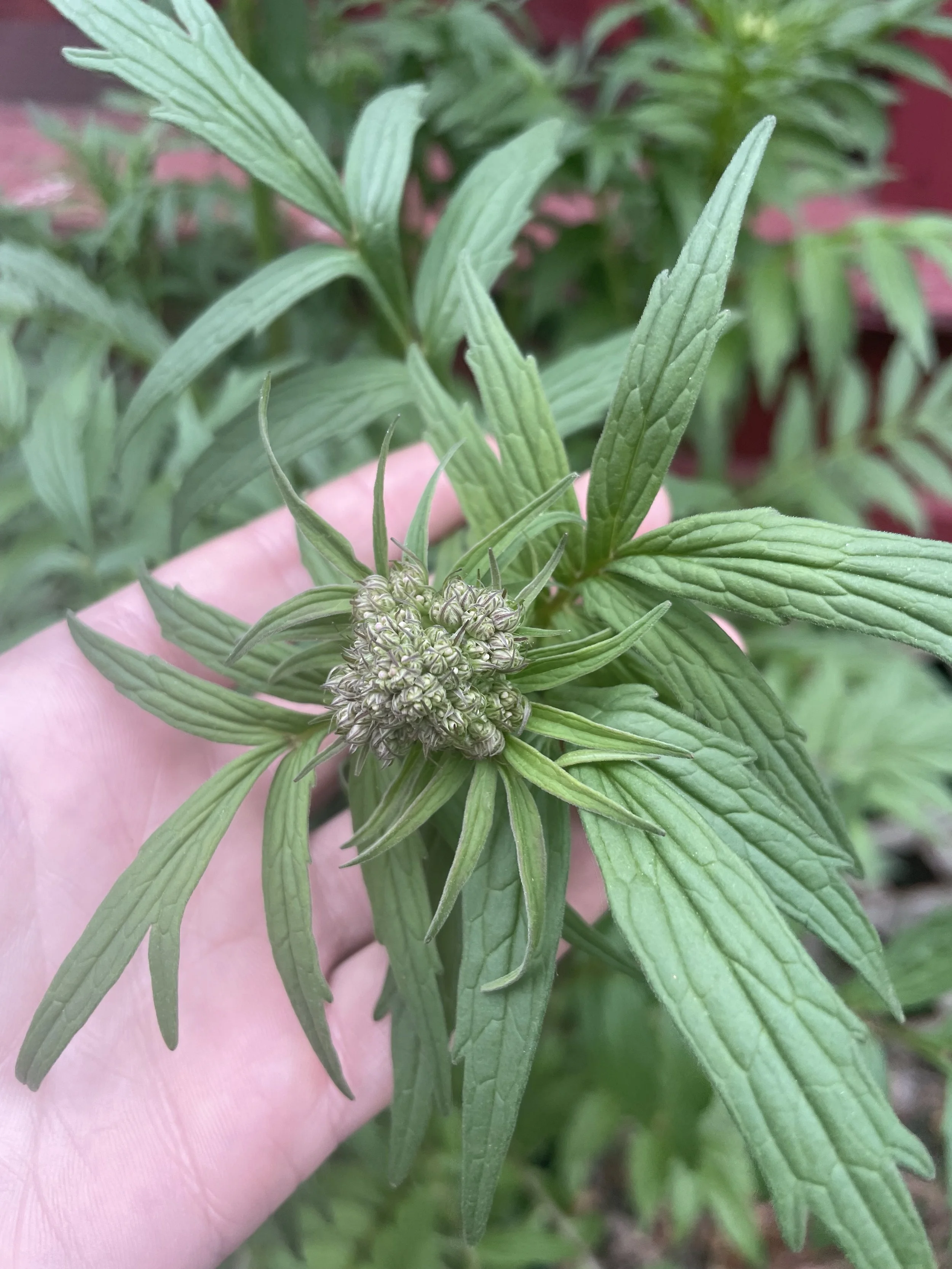Valerian
HABITAT
Valeriana officinalis also known as self-heal is a native to Asia and Europe. From the family Valerianaceae that is now part of the Caprifoliaceae family or honeysuckle family. Growing up to six feet tall this plant has opposite compound leaves, hollow stems, and pinkish white flowers that have a sweet scent. She spreads through rhizome and seed production growing bushy and vigorous. Valerian likes full sun to part shade and consistently moist soil preferring cooler weather. As this is an invasive plant to the US I always plant in a container and make sure to harvest the seeds, so it does not spread furthermore. This plant attracts tons of pollinators including flies, butterflies, and moths. Although insects cannot reproduce on non-native plants Valerian is still providing food for our most beloved pollinators. It is still important to plant native plants along with our trusty non-native herbs we love to grow for food and medicine.
PARTS USED
The stems, roots, and leaves of Valerian are all edible! This plant is mainly used for the root, yet the stems and leaves have potent active constituents that are useful for medicine making. The smell of the root is often considered to be that of dirty socks, yet others enjoy the funky smell compared to more of a funk cheese. Valerian was a popular food during the Middle Ages. The root was ground into some flour for bread making and the leaves were added to soups and stews! It is great to forage invasive plants as this helps remove them from the environment and provide tons of nutrients for us that our bodies are not used to eating. A great source of calcium, with high concentrations of selenium, tin, aluminum, chromium, iron, and magnesium. The leaves can also be used to make a muscle salve as valerian is known to be antispasmodic. Another option is a bedtime tincture using the root and or leaves for its sedative properties.
HERBAL BENEFITS
Valeriana officinalis is loaded with herbal benefits and is most popularly used for its sedative properties. This plant has been used for centuries to ease anxiety, nervousness, restlessness, stress, fatigue, cramps, and insomnia. Valerian is known as the number one nonprescription sedative in Europe! It’s also been used as a nervine, nervous system tonic, emmenagogue, antispasmodic, sedative, stomachic, expectorant, and hypnotic. Valerenic acid and valerenol are found in this plant and they act on GABA receptors which can regulate emotions, reduce pain, and help with sleep! Valerenic acid has also been shown to inhibit an enzyme that destroys GABA receptors meaning it protects our GABA receptors from being destroyed. Another compound in Valerian called valepotriates, which gives the roots its pungent smell, is known as anti-depressant and anti-anxiety. A clinical trial showed that this plant also helps treat OCD disorder. This study showed great results and a decrease in OCD behavior while taken everyday for a month compared to the placebo group. In the study on sleep most of the group fell asleep faster, woke up less, and slept longer than the placebo group. There are not many studies done on plant medicine even though it is the oldest form of healing. I deeply trust that mother earth provides us with everything we need to stay healthy and strong and prevent disease, we just have to trust her. This plant is also known as warming, drying, bitter (roots), and sweet (flowers.)
DOSE
It is suggested that Valerian is safe for short term use, studies have safely been conducted using Valerian for 28 days. As with everything excess is never good, I always try to change up the teas, tinctures, and food I am consuming. This herb is not safe for pregnant or breastfeeding women. Valerian should not be taken with alcohol or sedatives. Some people may have an adverse effect, but this herb is normally well tolerated. Some side effects include vivid dreams, dizziness, and headache. Always trust your body and start with small amounts! I have always had a great experience with Valerian.
LORE
This history of Valeriana officinalis is vast and dates back to ancient Greece and Rome. First described by Hippocrates (460-370 B.C.) and later prescribed by Galen (129 AD – 200 AD) as a remedy for insomnia, the history of this plant is rich. This plant was the middle ages benzodiazepine (xanax) used for over worrying and hysteria. The Nordic goddess Hertha was said to have used valerian as a whip to get her horse to run as fast as the wind! It was known back in the day to tame the wildest of beasts' that ran free. This herb is even mentioned in the Harry Potter book series for sleep. In the magical realm Valerian was used by women to lure men in and for love potions. It is even mentioned in the German tale of Pied Piper of Hamelin, the man who played his flute. Hildegard of Binger (1098 – 1179) notes using this herb as a tranquillizer . Valerian is generally regarded as a feminine element, used for love, sleep, protection, and purification! It is amazing that most herbs have been used since before we can fathom, yet sad to think herbal medicine has been thrown to the curb since the introduction of allopathic medicine. On a happy note herbal medicine has been growing in popularity and can be used with allopathic medicine. Both are a beautiful gift to us to heal our bodies!
REFERENCES
Stille A. Therapeutics and Materia Medica: A Systematic Treatise of the Action and Uses of Medicinal Agents, Including Their Description and History. 4th ed. Philadelphia: Henry C. Lea, 1874.
Edes RT. Therapeutic Handbook of the United States Pharmacopeia. New York: William Wood & Company, 1883.
Pereira J. The Elements of Materia Medica and Therapeutics. Philadelphia: Lea and Blanchard, 1846.
The herbal academy



